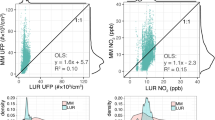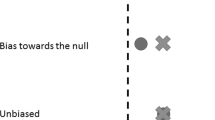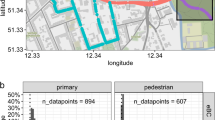Abstract
Background
Land use regression (LUR) models are commonly used in environmental epidemiology to assign spatially resolved estimates of air pollution to study participants. In this setting, estimated LUR model parameters are assumed to be transportable to a main study (the ‘‘transportability assumption’’). We provide an empirical illustration of how violation of this assumption can affect exposure predictions and bias health-effect estimates.
Methods
We based our simulation on two existing LUR models, one for nitrogen dioxide, the other for particulate matter with aerodynamic diameter <2.5 μm. We assessed the impact of error in exposure determinants used in the LUR models on resultant air pollution predictions and on bias in an exposure-health-effect estimate assessed in a hypothetical cohort. We assigned error to predictors at monitoring sites (sites used to develop the LUR model) and at prediction sites (sites for which exposure predictions were needed), allowing for different error levels between site types.
Results
Realistic error in the exposure determinants of the selected LUR models did not induce large additional error in exposure predictions and resulted in only minor (<1%) bias in health-effect estimates. Bias in the health-effect estimates strongly increased (up to 13.6%) when exposure determinant errors were different for monitoring sites than for prediction sites.
Conclusions
These results suggest that only modest reductions in bias in estimated exposure health-effects are to be expected from reducing error in exposure determinants. It is important to avoid heterogeneous errors in exposure determinants between monitoring sites and prediction sites to satisfy the transportability assumption and avoid bias in estimated exposure health-effects.
This is a preview of subscription content, access via your institution
Access options
Subscribe to this journal
Receive 6 print issues and online access
$259.00 per year
only $43.17 per issue
Buy this article
- Purchase on Springer Link
- Instant access to full article PDF
Prices may be subject to local taxes which are calculated during checkout


Similar content being viewed by others
References
Hoek G, et al. A review of land-use regression models to assess spatial variation of outdoor air pollution. Atmos Environ. 2008;42:7561–78.
Eeftens M, et al. Development of land use regression models for PM(2.5), PM(2.5) absorbance, PM(10) and PM(coarse) in 20 European study areas; results of the ESCAPE project. Environ Sci Technol. 2012;46:11195–205.
Beelen R, et al. Development of NO2 and NOx land use regression models for estimating air pollution exposure in 36 study areas in Europe—The ESCAPE project. Atmos Environ. 2013;72:10–23.
Beelen R, et al. Effects of long-term exposure to air pollution on natural-cause mortality: an analysis of 22 European cohorts within the multicentre ESCAPE project. Lancet. 2014;383:785–95.
Fuertes E, et al. Associations between particulate matter elements and early-life pneumonia in seven birth cohorts: Results from the ESCAPE and TRANSPHORM projects. Int J Hyg Environ Health. 2014;217:819–29.
Stafoggia M, et al. Long-term exposure to ambient air pollution and incidence of cerebrovascular events: results from 11 European cohorts within the ESCAPE project. Environ Health Perspect. 2014;122:919–25.
Fuks KB, et al. Arterial blood pressure and long-term exposure to traffic-related air pollution: an analysis in the European Study of Cohorts for Air Pollution Effects (ESCAPE). Environ Health Perspect. 2014;122:896–905.
Cai Y, et al. Cross-sectional associations between air pollution and chronic bronchitis: an ESCAPE meta-analysis across five cohorts. Thorax. 2014;69:1005–14.
Adam M, et al. Adult lung function and long-term air pollution exposure. ESCAPE: a multicentre cohort study and meta-analysis. Eur Respir J. 2014;45:38–50.
Cesaroni G, et al. Long term exposure to ambient air pollution and incidence of acute coronary events: prospective cohort study and meta-analysis in 11 European cohorts from the ESCAPE Project. BMJ. 2014;348:f7412.
Pedersen M, et al. Ambient air pollution and low birthweight: A European cohort study (ESCAPE). Lancet Respir Med. 2013;1:695–704.
Gryparis A, Paciorek CJ, Zeka A, Schwartz J, Coull BA. Measurement error caused by spatial misalignment in environmental epidemiology. Biostatistics. 2009;10:258–74.
Spiegelman D. Approaches to uncertainty in exposure assessment in environmental epidemiology. Annu Rev Public Health. 2010;31:149–63.
Carroll, RJ, Ruppert, D, Stefanski, LA, Crainiceanu, CM. Measurement error in nonlinear models: A modern perspective, 2nd ed. 2006. Boca Raton, FL: Chapman & Hall/CRC Press.
Cyrys J, et al. Variation of NO2 and NOx concentrations between and within 36 European study areas: Results from the ESCAPE study. Atmos Environ. 2012;62:374–90.
Eeftens M, et al. Spatial variation of PM2.5, PM10, PM2.5 absorbance and PMcoarse concentrations between and within 20 European study areas and the relationship with NO2—Results of the ESCAPE project. Atmos Environ. 2012;62:303–17.
Mendoza D, et al. Implications of uncertainty on regional CO2 mitigation policies for the U.S. onroad sector based on a high-resolution emissions estimate. Energy Policy. 2013;55:386–95.
Kadaster. Address Coordinates Netherlands (ACN)—Quality survey 2000 [Adres Coordinaten Nederland (ACN)—Kwaliteitsonderzoek 2000]. 2001. Apeldoorn, The Netherlands: Kadaster.
Beekhuizen J, et al. Impact of input data uncertainty on environmental exposure assessment models: A case study for electromagnetic field modelling from mobile phone base stations. Environ Res. 2014;135C:148–55.
Jacquemin B, et al. Impact of geocoding methods on associations between long-term exposure to urban air pollution and lung function. Environ Health Perspect. 2013;121:1054–60.
Brunekreef B, et al. The prevention and incidence of asthma and mite allergy (PIAMA) birth cohort study: Design and first results. Pediatr Allergy Immunol. 2002;13(Suppl 1):55–60.
Gehring U, et al. Air pollution exposure and lung function in children: The ESCAPE project. Environ Health Perspect. 2013;121:1357–64.
Hagemann R, et al. Spatial variability of particle number concentrations and NOx in the Karlsruhe (Germany) area obtained with the mobile laboratory ‘AERO-TRAM’. Atmos Environ. 2014;94:341–52.
Mazumdar S, Rushton G, Smith BJ, Zimmerman DL, Donham KJ. Geocoding accuracy and the recovery of relationships between environmental exposures and health. Int J Health Geogr. 2008;7:13.
Szpiro AA, Sheppard L, Lumley T. Efficient measurement error correction with spatially misaligned data. Biostatistics. 2011;12:610–23.
Szpiro AA, Paciorek CJ. Measurement error in two-stage analyses, with application to air pollution epidemiology. Environmetrics. 2013;24:501–17.
Lopiano KK, Young LJ, Gotway CA. A comparison of errors in variables methods for use in regression models with spatially misaligned data. Stat Methods Med Res. 2011;20:29–47.
Lopiano KK, Young LJ, Gotway CA. Estimated generalized least squares in spatially misaligned regression models with Berkson error. Biostatistics. 2013;14:737–51.
Chang HH, Peng RD, Dominici F. Estimating the acute health effects of coarse particulate matter accounting for exposure measurement error. Biostatistics. 2011;12:637–52.
Basagaña X, et al. Measurement error in epidemiologic studies of air pollution based on land-use regression models. Am J Epidemiol. 2013;178:1342–6.
Alexeeff SE, et al. Consequences of kriging and land use regression for PM2.5 predictions in epidemiologic analyses: Insights into spatial variability using high-resolution satellite data HHS Public Access. J Expo Sci Env Epidemiol. 2015;2540:138–44.
Acknowledgements
This work was supported by grant 211250 (ESCAPE) and grant 308610 (EXPOSOMICS) from the European Community’s Seventh Framework Program (FP7/2007–2011).
Author information
Authors and Affiliations
Corresponding author
Ethics declarations
Conflict of interest
The authors declare that they have no conflict of interest.
Electronic supplementary material
Rights and permissions
About this article
Cite this article
Vlaanderen, J., Portengen, L., Chadeau-Hyam, M. et al. Error in air pollution exposure model determinants and bias in health estimates. J Expo Sci Environ Epidemiol 29, 258–266 (2019). https://doi.org/10.1038/s41370-018-0045-x
Received:
Revised:
Accepted:
Published:
Issue Date:
DOI: https://doi.org/10.1038/s41370-018-0045-x
Keywords
This article is cited by
-
Using crowd-sourced low-cost sensors in a land use regression of PM2.5 in 6 US cities
Air Quality, Atmosphere & Health (2022)
-
Fine-Scale Air Pollution Models for Epidemiologic Research: Insights From Approaches Developed in the Multi-ethnic Study of Atherosclerosis and Air Pollution (MESA Air)
Current Environmental Health Reports (2021)



